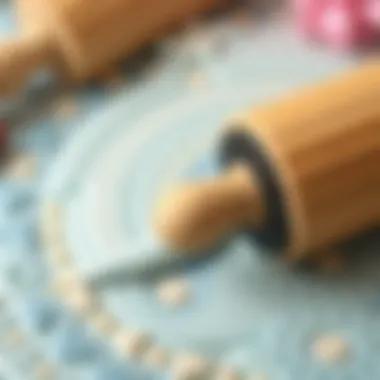Exploring the Versatility of Polymer Clay Rolling Pins


Intro
In the bustling world of fashion and crafts, the versatility of tools can set a project apart. Among these tools, polymer clay rolling pins stand out as unsung heroes. Unlike their traditional wooden counterparts, these innovative rolling pins are crafted exclusively from polymer clay, which offers a unique combination of functionality and creative potential.
While one might think of rolling pins as strictly utilitarian, they hold unexpected value in various contexts. From intricate designs in crafting to significant contributions in fashion design and sustainable practices, these pins garner a closer look. Crafting not only requires skills but also the right tools to bring visions to life. Having the right instrument can help professionals, enthusiasts, and even casual creators navigate their artistic landscape more profoundly.
In this article, we will explore the realm of polymer clay rolling pins, highlighting their material composition, design variations, practical applications, and maintenance. We will also touch upon the role these tools might play in sustainable practices within the fashion world. With a spotlight on current fashion trends and ethical considerations, we'll map out how these rolling pins can amplify innovation and creativity in clothing-related projects.
Understanding Polymer Clay Rolling Pins
Polymer clay rolling pins are more than mere kitchen implements; they are pivotal tools in the crafting world. These specialized pins offer crafters the ability to create flat, consistent sheets of clay, which can be critical for various artistic endeavors. Understanding the versatility and benefits of these rolling pins can significantly enhance one's creative process. Their design and material allow for a smoother rolling experience, making them not just functional but also an extension of one's artistic expression.
Definition and Purpose
A polymer clay rolling pin is a tool designed specifically for flattening and shaping polymer clay. These pins are typically made of materials like acrylic or silicone, which provide a non-stick surface, ensuring that clay doesn't cling during use. The main purpose of these rolling pins is to help crafters achieve an even thickness across their clay sheets, which is essential for both aesthetic and structural integrity in projects.
Using these rolling pins allows for precise control over the thickness of the clay, making them invaluable for intricate designs where uniformity is crucial. They also facilitate the application of textures, impressions, and patterns, elevating the final product. Some crafters even leverage their rolling pins to create distinctive designs, manipulating the clay in ways that traditional rolling pins simply cannot achieve.
Comparison with Traditional Rolling Pins
While traditional rolling pins can do the job in a pinch, they often fall short when it comes to the unique needs of polymer clay crafting. Here's a closer look at how they stack up against their polymer counterparts:
- Material Differences: Traditional rolling pins are commonly made of wood, which can absorb moisture and contain imperfections, affecting the clay’s finish. Polymer clay rolling pins, often made from smooth acrylic or silicone, offer a non-absorbent surface that helps maintain the clay’s integrity.
- Size and Shape Variations: Polymer clay rolling pins come in a variety of shapes and sizes tailored for specific crafting needs. Some may feature handles, while others may be designed for better grip with certain types of clay. Traditional rolling pins generally stick to a basic shape and size, limiting versatility.
- Ease of Use: The lightweight nature of polymer clay rolling pins allows for ease in maneuvering, giving crafters more control and reducing strain during long projects. Traditional pins can be heavier and more cumbersome, which could lead to fatigue.
By understanding these differences, enthusiasts can make informed decisions that elevate their crafting experience, ensuring they choose the right tool for their artistic journey.
Material Composition of Polymer Clay Rolling Pins
When delving into the world of polymer clay rolling pins, understanding their material composition is vital. The materials used in these tools not only influence their performance but also affect the outcome of your crafting projects. In this section, we will examine the types of materials employed in the manufacture of polymer clay rolling pins and discuss their durability and longevity, which are essential factors for both casual crafters and professional designers alike.
Types of Materials Used
Polymer clay rolling pins can be crafted from a variety of materials, each bringing unique qualities to the table. The most prominent materials include:
- Acrylic: This is often a top choice among artists. Acrylic rolling pins are lightweight, smooth, and non-stick, making them perfect for rolling out various types of clay without sticking. Their translucent nature also allows users to see the thickness of the clay, ensuring even application.
- Wood: Wooden rolling pins carry a classic charm. Although heavier than their acrylic counterparts, they can provide a more traditional feel while working. However, wood can absorb moisture and oils from the clay, which may lead to some staining over time if not properly cared for.
- Metal: Less common than acrylic and wood, metal rolling pins are typically very durable. Their weight can help in rolling out thicker materials, but they require more effort to keep clean and can be prone to sticking if not treated with a non-stick spray.
The selection of material often comes down to personal preference and the specific needs of your project. For example, if you're aiming for precision and ease of use, acrylic may be the way to go, while wooden options might appeal to those who appreciate a tactile connection to their craft.
Durability and Longevity
Durability and longevity in polymer clay rolling pins refer not only to the lifespan of the tools themselves but also to their ability to withstand the rigors of repeated use. For anyone invested in crafting, choosing a rolling pin that can handle the wear and tear is crucial.
- Acrylic rolling pins tend to resist cracking and scratching, especially if they are of high quality. They require minimal maintenance—just a simple wipe down after use—and can last for many crafting sessions.
- Wooden rolling pins can be incredibly durable, but their longevity can often depend on how they are cared for. Regular oiling helps keep the wood maintained and prevents it from splitting or absorbing moisture.
- Metal rolling pins are robust and last a long time; however, their surface can become scratched and pitted over time, which affects their functionality. Using silicone covers can help extend their usability while adding a layer of protection.
In crafting circles, it’s often said, "Choose wisely, and it’ll serve you well," and that’s especially true for rolling pins. Knowing their composition informs not only your selections but also your expectations regarding the lifespan of these tools. A well-chosen rolling pin enhances the crafting experience, fosters creativity, and ultimately contributes to the quality of the finished project.
"Understanding the materials translates to better creations. When your tools resonate with your style, they become extensions of your creativity."
Selecting an effective rolling pin can make all the difference in achieving a flawless finish, ensuring a successful transformation of ideas into actual designs.


Design Variations
In the realm of polymer clay rolling pins, design variations hold a significant place. Not only do they cater to the practical needs of craft enthusiasts, but they also open doors to creative possibilities that can elevate any project. Understanding design choices helps artisans to find tools that align with their vision, enhancing not just the functionality but the aesthetic quality of their creations. By considering various forms and features, artists are better equipped to select rolling pins that serve their intended purpose while also reflecting personal style.
Shape and Size Options
When it comes to shape and size, the choices are as diverse as the imaginations of their users. Polymer clay rolling pins come in a variety of dimensions—from petite, hand-held designs that allow for precision work on smaller projects to larger, traditional sizes suitable for extensive flatwork. One should think about what kinds of projects they are most likely to undertake:
- Miniature projects: A smaller, narrower rolling pin is ideal for crafting tiny pieces like beads or flat components for jewelry.
- Broader designs: Wider pins work well for projects such as creating sheets of polymer clay for larger sculptures or decorative elements.
- Unique shapes: Some manufacturers offer rolling pins with ergonomic designs that facilitate easier handling. An example is the pin that tapers at the ends, making it easier to roll out dough without exerting excessive force.
This variety allows crafters to pick tools that not only suit the size of their workspace but also their manipulation style. The right size can drastically affect the ease of use and, ultimately, the outcome of the work.
Textured Rolling Pins
Textured rolling pins add another layer of complexity and versatility, distinguishing them in the market. These pins are engraved or imprinted with intricate designs, allowing users to transfer unique patterns onto their polymer clay. The creativity unleashed by these textured surfaces cannot be overstated, as they can mimic natural elements like wood grains, floral motifs, or even geometric shapes.
Using a textured rolling pin can transform a mundane piece of clay into a work of art without much additional effort. Popular uses include:
- Creating backgrounds for sculptures or themed crafts that require specific textures.
- Making jewelry with unique designs that stand out in a competitive market.
- Enhancing fabric designs in DIY clothing projects, providing a personal touch to garments.
As a tip, when selecting a textured rolling pin, look for one made of high-quality materials. This ensures longevity and that the designs remain crisp after repeated use. To fully harness the potential of these tools, experimenting with different textures is highly encouraged. Indeed, the patterns you can imprint may lead you down unexpected and innovative design paths.
"The beauty of crafting lies in the endless possibilities; with the right tools, the only limit is your imagination."
In summary, whether through different shapes and sizes that cater to specific crafting needs or the dynamic capabilities offered by textured rolling pins, design variations significantly influence how polymer clay artists express their creativity. These elements not only improve functionality but can also inspire new artistic approaches.
Practical Applications in Crafting
The role of polymer clay rolling pins in crafting is not merely functional; it encompasses a myriad of artistic possibilities. These tools have become invaluable for artists and designers who seek to elevate their work. The adaptability of rolling pins allows for both precision and creativity, making them essential in various crafting processes. Here, we explore the specific applications of these rolling pins to highlight their influence in the world of crafts.
Use in Polymer Clay Projects
When it comes to working with polymer clay, the rolling pin is akin to a maestro conducting an orchestra. It helps to evenly flatten and thin out the clay, ensuring a smooth surface devoid of bubbles and imperfections. This is critical for achieving professional-looking results in creations ranging from intricate jewelry pieces to elaborate figurines. Moreover, many crafters appreciate textured rolling pins that embed patterns into the clay. These unique textures can create stunning effects that add dimension to a project. Simply put, the rolling pin is not just a tool; it’s an extension of a creator's vision.
"A rolling pin in crafting is like a brush in painting; it's not just about the action, but the creativity it can bring alive."
Involvement in Textile Design
Polymer clay rolling pins also find their place in the textile design arena. Designers can use these tools to create unique fabric patterns or embellishments that cannot be achieved with traditional methods. For instance, rolling pins with specific designs can impress patterns onto fabric, making fabric manipulation more efficient and enhancing aesthetic appeal. This interplay of clay and fabric has opened new doors for textile artists, allowing them to merge disciplines and generate innovative designs that speak to the modern ethos of versatility.
Role in DIY Fashion Projects
In the domain of DIY fashion, polymer clay rolling pins serve multifaceted purposes. They can be utilized to craft custom buttons, decorative elements, or even entire pieces of jewelry. The beauty of involving these pins in fashion is their ability to transform simple clay into intricate designs that resonate with personal style. Beyond that, they offer an avenue for sustainable fashion practices by enabling creators to repurpose leftover materials and breathe new life into outdated garments. This incorporation of rolling pins into the fabric of our wardrobe symbolizes a shift towards more personal, handmade fashion concepts.
Maintenance and Care
Proper care and maintenance of polymer clay rolling pins significantly contributes to their longevity and functionality. As these tools become an essential part of a crafter's toolkit, understanding their upkeep is crucial. Regular maintenance ensures that you can consistently create beautiful works without hindrance. Additionally, well-maintained tools can enhance your crafting experience immensely, providing smooth, enjoyable use while helping to prevent mishaps that can arise from neglect.
Cleaning Techniques


Keeping your polymer clay rolling pins clean is of utmost importance to preserve both their appearance and functionality. Here are some effective cleaning techniques:
- Gentle Soap Solution: A soft sponge or cloth soaked in warm, soapy water works wonders. Avoid harsh abrasives, which can scratch the surface.
- Isopropyl Alcohol: This can be used to remove more stubborn residues. Just dampen a cloth and wipe the pin, ensuring it’s rinsed properly afterward.
- Avoid the Dishwasher: While it might be tempting, putting these pins in a dishwasher can warp or damage them due to high temperatures. Stick to hand cleaning for best results.
- Conditioners for Clay Residue: If clay residue seems stuck, consider using a clay conditioner or a small amount of mineral oil. Just a dab can help break down the leftovers, making them easier to wipe away.
Even after your rolling pins seem clean, make a habit of examining them for any residual materials or imperfections. A quick once-over can save you a lot of trouble down the line.
Storage Recommendations
Storing your polymer clay rolling pins properly can enhance their lifespan and ensure they’re always ready to go when inspiration strikes. Here are some practical storage suggestions:
- Vertical Placement: If space allows, store them in a vertical position to prevent warping. This keeps them from contacting flat surfaces that may lead to uneven shapes.
- Protective Sleeves: Consider using protective sleeves or cases. These not only avoid scratches but can also prevent dust accumulation.
- Avoid High Temperatures: Keeping your rolling pins away from direct sunlight and heat sources preserves the integrity of the material and prevents any potential warping.
- Dedicated Storage Space: Allocate a specific drawer or container for your rolling pins alongside similar tools. Keeping them organized can save time during crafting sessions.
Proper maintenance, including regular cleaning and mindful storage, not only extends the life of your rolling pins but also enhances your creative process.
In summary, the care and maintenance of polymer clay rolling pins involve a bit of effort, but the payoff is substantial. By practicing good cleaning habits and ensuring your tools are stored safely, you're setting yourself up for success in your crafting endeavors.
Sustainability Considerations
As the world increasingly turns its gaze towards sustainable practices, the conversation surrounding crafting tools like polymer clay rolling pins takes on new significance. Crafting has often been seen as a personal, creative outlet, but it has also come under scrutiny regarding its environmental impact. Understanding the sustainability considerations associated with these tools not only aligns our creative endeavors with eco-conscious principles but also helps inform purchasing and usage decisions.
Eco-Friendly Materials
When it comes to polymer clay rolling pins, the materials employed in their production can vary widely. Many artisans and companies are striving to incorporate eco-friendly options into their manufacturing processes. For instance, some practitioners lean towards using non-toxic, biodegradable polymers. This contrasts sharply with traditional plastic rolling pins which may contain harmful chemicals, and it reflects a growing awareness and commitment to sustainability within the crafting community.
- Biodegradable Polymers: These are designed to decompose naturally, minimizing landfill waste.
- Recycled Materials: Some rolling pins are made from up-cycled products, further reducing the need for virgin materials.
- Natural Finishes: An increasing number of manufacturers opt for natural oils and waxes instead of synthetic finishes, resulting in less chemical exposure for both crafters and the environment.
Using materials that are both safe for the user and environmentally conscious not only reduces ecological footprints but also promotes healthier crafting experiences, encouraging artisans to feel good about their tools.
Impact on Fashion Sustainability
In the realm of fashion, polymer clay rolling pins can play a pivotal role in enhancing sustainability. They offer a unique blend of versatility and practicality, which aids in reducing waste and promoting ethical fashion practices. Here are some key impacts:
- Minimal Waste Production: By enabling designers to create custom fabrics or embellishments, these tools help minimize leftover materials. Using every scrap of polymer clay means less waste in the production phase.
- Encouraging Upcycling: Many fashion designers use rolling pins to transform pre-existing materials into new creations. This practice fosters a culture of recycling and upcycling in fashion, combatting fast-fashion tendencies.
- Affordable Crafting Alternatives: With the rising cost of purchasing ready-made clothing, handmade items crafted with polymer clay rolling pins offer affordable options for consumers. These unique pieces can be not only fashionable but also sustainably produced.
- Localized Production: Crafting with rolling pins allows for local design practices, reducing transportation emissions associated with large scale garment production.
As awareness of fashion sustainability grows, the demand for tools that align with eco-conscious principles, like polymer clay rolling pins, will likely increase. Supporting such innovations reinforces the idea that creativity can go hand-in-hand with environmental responsibility.
"Crafting is not just about expression; it's also about making choices that positively impact our world."
Innovative Uses Beyond Crafting
The world of polymer clay rolling pins extends well beyond the obvious realms of crafting and design. Their versatility makes them a valuable asset in various unexpected areas, particularly in culinary arts and the fine arts of sculpture. This expansive utility showcases not only the functional aspects but also the creative potential that resides within these seemingly simple tools. With their unique composition and design, polymer clay rolling pins find innovative applications that can surprise even seasoned enthusiasts.
In Culinary Arts
In kitchens across the globe, polymer clay rolling pins are making a notable entry, proving to be just as adept in the culinary domain as they are in crafting. Though traditionally, wood or marble has dominated the rolling pin scene, the shift towards polymer clay is commendable.
Firstly, these rolling pins often come with a variety of textures and designs that can imprint unique patterns onto pastry, dough, or even fondant. This capability transcends the utilitarian aspect of rolling out ingredients, making them a tool of artistry in baking. For instance, a textured rolling pin can allow bakers to create stunning patterns on cookies or pie crusts. This not only enhances the visual aesthetic of desserts but also adds innovative flair to culinary presentations.
Moreover, polymer clay rolling pins are typically lightweight and easy to handle. This can streamline the process of preparing dough for pastries or cookies. Their non-porous surface means they are also less likely to absorb odors or moisture, which is a significant advantage in food preparation. For cooks who value hygiene, this quality makes polymer clay rolling pins a preferred choice.


Notably, some creative chefs have started to experiment with custom-made polymer rolling pins tailored for specific cuisines. For example, a rolling pin designed with Indian motifs can be instrumental in preparing Indian breads, allowing cooks to marry tradition and innovation seamlessly.
Art and Sculpture Endeavors
Beyond the kitchen, polymer clay rolling pins take center stage in the realm of art and sculpture. Artists and sculptors are discovering that these tools, with their varied sizes and textures, can be utilized to manipulate different materials creatively.
For sculptors, the ability to roll and flatten clay with precision cannot be overstated. The smooth surfaces facilitate the creation of intricate designs and patterns that can enhance artwork significantly. Artists often employ these rolling pins to blend colors and textures, leading to unique mixed-media pieces or even larger installations.
Furthermore, the artistic use of polymer rolling pins is not limited to clay alone. They can be excellent for working with materials like gelatin or even sculpture wax. The understanding of how these rolling pins engage with various mediums opens up a vista of creative opportunities. In educational settings, they are used to teach fundamental techniques in hands-on workshops, allowing budding sculptors to gain familiarity with the tools of their trade.
"The beauty of the polymer clay rolling pin lies in its capacity to serve both the repeating formulas of the culinary world and the free-form universe of artistic expression."
Buying Guide for Polymer Clay Rolling Pins
When considering the purchase of a polymer clay rolling pin, understanding its significance in crafting activities of all kinds is essential. The versatility of these tools makes them much more than just functional items; they’re pivotal in achieving precision and creativity in your projects. Since polymer clay rolling pins come in various styles and materials, it is vital to know what to look for to make an informed decision.
Choosing wisely can make all the difference in your crafting journey. A carefully selected rolling pin can enhance your work efficiency, improve the quality of your finishes, and even inspire greater creativity.
What to Look For
Looking for the right polymer clay rolling pin might feel like finding a needle in a haystack, given the wide variety available. Here are several critical factors to ponder when making your selection:
- Material Composition: Different materials lend distinct qualities to your rolling pin. Consider whether you prefer plastic, which is lightweight and easy to clean, or wood, which provides a sturdier feel.
- Diameter and Length: Depending on the size of your clay projects, a longer or wider pin might be required. Think about what suits your specific crafting style best.
- Texture and Design: Some rolling pins come with textures that can add intricate designs to your polymer clay. If you want additional dimension to your work, these can be valuable.
- Weight: Heavier rolling pins can have more force behind them, making it easier to roll out clay without applying too much pressure. However, this might not be ideal for everyone.
- Ease of Cleaning: Consider how easy it is to maintain the rolling pin. Some materials can absorb color or stick to clay, while others may clean up more readily.
Taking the time to evaluate these aspects can lead to better results and a more enjoyable crafting experience.
Price Points and Quality
When it comes to the pricing of polymer clay rolling pins, several factors influence the cost:
- Material Quality: Higher quality materials typically command a higher price. For instance, a wooden rolling pin made from maple may be more expensive than a plastic one but often provides a superior crafting experience.
- Brands and Reputation: Established brands often bear a premium due to their reputation for quality and durability. Investing in a well-regarded brand might save you in the long run.
- Features: Pins with specialized features, like textured surfaces for imprinting, tend to be priced higher than standard models. If these features align with your crafting goals, the extra cost may be worth it.
The initial price of these rolling pins can vary widely, from as little as ten dollars for basic options, even up to fifty and beyond for those with specialized features. Consider your budget alongside how often you will use the rolling pin and how it fits into your long-term crafting needs.
It’s often wiser to invest in a quality tool that lasts than to frequently replace a lower-priced item.
Starting with a reliable and well-built polymer clay rolling pin can set a solid foundation for many future projects, enriching both your creative process and the results you obtain.
End and Future Trends
As we wrap up this exploration into polymer clay rolling pins, it’s essential to recognize their growing significance in both the crafting and fashion sectors. These versatile tools are not solely about rolling; they symbolize innovation, creativity, and a push towards sustainability in artistic practices. The modern consumer and creator alike are now more aware of the environmental implications of their choices, and polymer clay rolling pins align with this consciousness by offering alternatives that reduce waste and promote eco-friendly materials.
Recap of Key Insights
Throughout this article, we've delved into various aspects of polymer clay rolling pins. To summarize:
- Definition & Purpose: These tools are designed primarily for working with polymer clay but extend to various applications in crafting and fashion.
- Material Composition: Understanding the materials involved helps in recognizing durability and how different compositions can affect the quality of both the product and the final crafts.
- Design Variations: With numerous shapes and textures, rolling pins can create unique designs that speak to individual creativity.
- Practical Applications: They’re not just for clay but also serve in fabric design and fashion, bridging gaps between different crafts.
- Maintenance & Care: Keeping rolling pins in good shape prolongs their usability, an important consideration for dedicated crafters.
- Sustainability: Many manufacturers are now producing eco-friendly options, catering to the environmentally-conscious consumers.
By highlighting these elements, we see the versatility of polymer clay rolling pins far exceeds traditional notions. They are indispensable tools that foster creativity and initiative in the crafting world.
Predictions for the Crafting Industry
Looking ahead, the crafting industry is likely to witness significant shifts driven by innovation and consumer demand. Here are a few predictions:
- Increased Customization: As crafters seek unique possibilities, manufacturers may focus on producing customizable or multifaceted rolling pins that cater to specific artistic needs.
- Sustainable Practices: The emphasis on sustainability will grow stronger. Expect rolling pins made from recycled materials or biodegradable options to emerge more prominently in the marketplace.
- Technology Integration: We could see the advancement of smart tools — rolling pins equipped with sensors that help in the precise application of pressure or thickness measurements, taking the guesswork out of crafting.
- Workshops and Learning: As awareness of these tools spreads, workshops could become more prevalent, allowing enthusiasts to learn how to incorporate them innovatively into their work.
- Fashion Collaborations: There may be a rise in collaborations between rolling pin manufacturers and fashion designers, unveiling limited edition patterns or designs that merge functionality with style.
The future looks bright for polymer clay rolling pins, reinforcing their role not just as tools but as catalysts for creative expression and sustainable practices in the crafting community.















